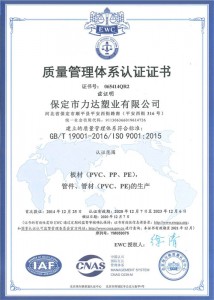Urr . 31, 2024 15:02 Back to list
HDPE Pipe Fittings for Efficient Irrigation Solutions and Water Management
Understanding HDPE Irrigation Pipe Fittings A Comprehensive Overview
High-Density Polyethylene (HDPE) is a popular choice for irrigation systems due to its durability, flexibility, and resistance to environmental stressors. HDPE pipes are lightweight and easy to install, making them an ideal solution for agricultural and landscaping applications. However, to ensure the efficiency of an irrigation system, the choice of fittings and connectors is equally important. In this article, we will explore the different types of HDPE irrigation pipe fittings, their benefits, and considerations for installation.
Types of HDPE Irrigation Pipe Fittings
1. Elbows HDPE elbows are used to change the direction of the pipe within an irrigation system. They come in various angles—most commonly 45-degree and 90-degree options—to accommodate the layout of the landscape. Properly fitted elbows help in maintaining water flow and pressure.
2. Tees These fittings allow for splitting the flow of water into two different directions. Tees are essential for creating sub-main or lateral lines from a main irrigation line, enabling more efficient coverage of larger agricultural fields or gardens.
3. Reducers Reducers are utilized to connect pipes of different diameters. In an irrigation system, they play a crucial role in transitioning between various pipe sizes based on flow requirements, thereby maintaining optimal pressure and water flow.
4. End Caps and Plugs Often used to terminate a pipe run, end caps and plugs effectively seal off the system where an irrigation line ends. This is particularly useful for maintaining pressure within the system and preventing water loss.
hdpe irrigation pipe fittings

5. Jointing Fittings These include couplings and unions that allow for the connection of two pipe sections. Proper jointing is crucial to ensure a leak-free and secure irrigation system.
Benefits of HDPE Fittings
The primary advantage of HDPE irrigation pipe fittings is their compatibility with HDPE pipes, which enhances the overall integrity of the irrigation system. HDPE fittings are resistant to UV rays, chemicals, and corrosion, which can significantly extend the life of the irrigation system. Additionally, they provide a high level of flexibility that allows for easier installation and maintenance.
Moreover, the lightweight nature of HDPE fittings reduces labor costs and time during installation. Their smooth internal surface minimizes friction loss, promoting better water flow and efficiency in irrigation operations.
Considerations for Installation
When installing HDPE irrigation pipe fittings, it is crucial to ensure that all components are compatible in size and pressure rating. Using the right types of fittings for specific applications can prevent leaks and promote efficient water distribution. Furthermore, each fitting must be properly aligned and secured to withstand the pressure exerted by the water flow.
In conclusion, HDPE irrigation pipe fittings play a vital role in the overall performance of irrigation systems. With their durability, versatility, and ease of installation, they provide a robust solution for effective water management in agricultural and landscaping projects. Optimal selection and installation of these fittings are essential to achieve the best results in any irrigation system, ultimately contributing to healthier crops or thriving landscapes.
-
High-Quality UPVC Water Supply Pipe for Durable Plumbing Solutions
NewsJul.23,2025
-
High-Quality PVC-M Water Supply Pipe for Reliable Plumbing Solutions
NewsJul.22,2025
-
High-Quality PVC Transparent Pipe with Clear Visibility & Durability
NewsJul.22,2025
-
Premium Wireless Headphones: Noise Cancelling & Long Battery | Order Now
NewsJul.21,2025
-
High-Quality PPR Pipes and Fittings Durable ERA PPR & PVC PPR Solutions
NewsJul.08,2025
-
Black HDPE Cutting Board - Durable, Non-Porous & Food Safe HDPE Plastic Cutting Board
NewsJul.08,2025

